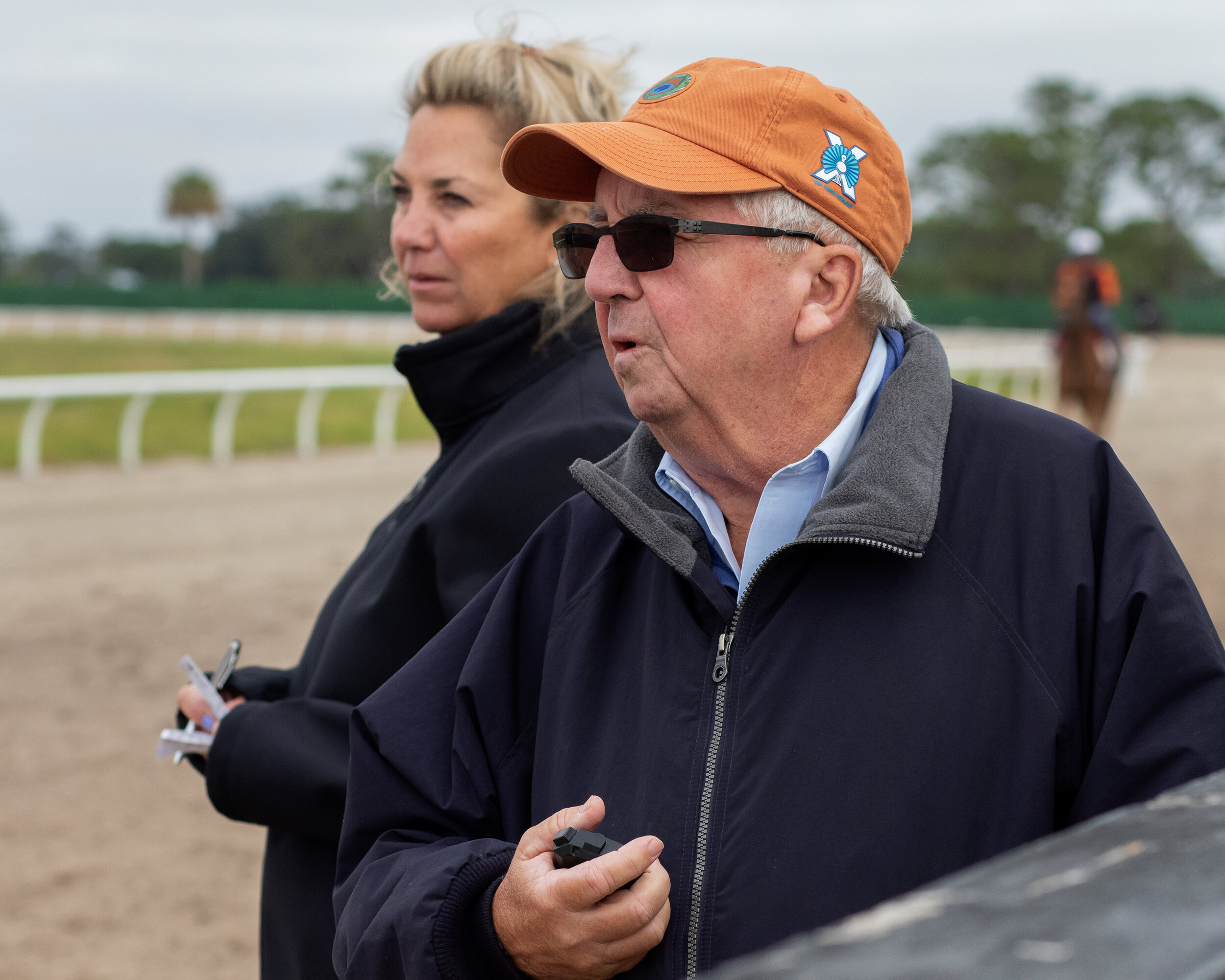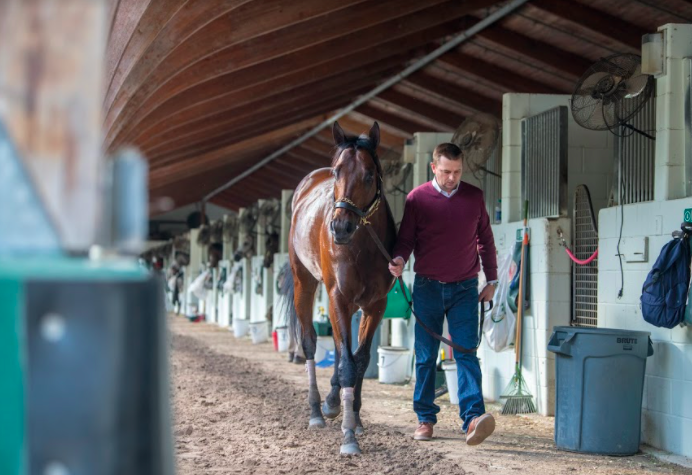Triple Crown 2021, issue 60
Contents
Purchase just this print issue - from just $8.95
Download a digital version of this issue - just $3.99
Spring 2021, issue 59
Contents
Bill Heller portrays Ron Moquett, co-owner and trainer of Whitmore and the team behind Whitmore – Ron’s wife Laura and former jockey Greta Kuntzweiler. Together, the Moquetts and Kuntzweiler reached that remarkable Breeders’ Cup moment when Whitmore won. Now Ron can dream of a repeat Breeders’ Cup victory.
How dirt tracks became safer in 2020
Ken Snyder compares tracks and explains which action Santa Anita and Fair Grounds in New Orleans took to make their tracks safer.
Nancy Sexton Looks back at the legacy Sunday Silence has left and why the stallion was a true game changer for the Japanese industry, not only as a brilliant source of elite talent but as a key to the development of Japan as a respected racing nation.
Understanding gene sequencing technology
Carol Hughes explains how every common gastrointestinal disease can be linked back to disturbances of the gut bacteria.
State breeding incentives for 2021
North America provides breeder and owner incentive programs to reward horsemen for producing quality bloodstock – Annie Lambert breaks these programs down State by State.
Establishing what a normal appetite looks like, Catherine Rudenko examines ways to encourage and maintain appetite throughout a season. The best planned feeding program in the world is of no use if the horse simply does not eat as required to sustain performance.
Bill Heller captures the Graded Stakes winning owners behind Colonel Liam, Kiss Today Goodbye and Tide of the Sea.
Georgie White investigates Stable Vices: Are they vices or a product of the environment?
Dr. Russell Mackechnie-Guire looks at the different types of bridles at the trainers’ disposal and what works best for which type of horse.
REGULARS
#soundbites - This quarter, Bill Heller asks if with increased restrictions on the use of Lasix, tracks should have agreed protocols with horsemen for the horse’s barn environment, covering ventilation / air flow and bedding?
BUY THIS ISSUE IN PRINT OR DOWNLOAD -
Spring 2021, issue 59
Print - $8.95
Download - $5.95
Breeders' Cup to Pegasus Cup, issue 58
Breeders' Cup to Pegasus / Issue 58
Contents
Strength, stamina & class - three attributes that describe not just Stonestreet Farm’s vibrant owner but also her farm’s mission to produce winning racehorses as Denise Steffanus discovers.
Outlook for stem cell therapy: its role in tendon regeneration
Debbie Guest is looking into the different treatments for horse tendon injuries that have been tested over the years.
Is the casino “band-aid” falling off? - Not at Oaklawn Park
Casinos at racetracks were always seen as a temporary fix to racing’s massive problem of not doing enough business to survive. Bill Heller on what happens when the band-aid falls off?
Georgie White explains the use of water for therapeutic benefit in the equine industry and hydrotherapy as a mechanism for enhancing performance in the racehorse.
Morning training of Thoroughbreds at tracks is standard, less standard is a collision between horses resulting in civil litigation. Peter Sacopulos examines such a case.
The benefit of using “yearling rollers”
Dr. Russell Mackechnie-Guire asks if a roller is a harmless piece of equipment or has it been previously overlooked?
Bill Heller profiles the owners behind Shedaresthedevil, Authentic, Starship Jubilee, and Peter J. Callahan’s Swiss Skydiver.
Catherine Rudenko investigates alternative and supportive therapies to find other means of reducing the risk or severity of EIPH.
Ed Golden takes us on a journey presenting Edward “Kip” Hannan, a man dedicated to preserving timeless treasures and ensconcing them in pantheons for future generations.
Trainer Robert Tiller and Canadian sprint legend Pink Lloyd both reached momentous milestones this year - Alex Campbell shares all.
Annie Lambert fills us in on Turf Paradise in Phoenix, Ariz. Sadly, there is a chance the Phoenix icon may never mythically rise from the ashes.
Regulars
This quarter, Bill Heller asks if the Racing Integrity Act, which will create uniform national medication rules and testing, and is seemingly on its way to becoming law, will be good or bad?
BUY THIS ISSUE IN PRINT OR DOWNLOAD -
Print - $8.95
Download - $5.95
Derby / Preakness / Sales, issue 57
Derby / Preakness / Sales 2020, issue 57
Contents
Bill Heller portrays Tommy Drury who became an overnight sensation after Art Collector’s victory in the Gr2 Blue Grass Stakes at Keeneland and is now looking forward to the Kentucky Derby.
An estimated 95% of American racehorses go postward on Lasix, a diuretic that reduces bleeding in the lungs caused by extreme exertion. Now, nearly 50 years since horsemen and veterinarians battled for approval to use the therapeutic drug on race day. Denise Steffanus talks to industry stakeholders who have launched an initiative to phase out Lasix from American racing.
Jeff Lowe explains how adapting to the new world with COVID-19 has led to a rapid integration of online bidding for Thoroughbred auctions across North America, presenting sale companies and consignors with a new challenge to supply potential buyers with enough information and technology for them to feel comfortable making a winning bid from afar.
The dominant limb - can we train a completely symmetrical horse? Georgie White investigates this very interesting theory.
Annie Lambert talks to Adrian Gonzales about his strategies for buying and selling at the yearling sales.
Dr Russell Mackechnie-Guire studies how the latest design concepts and technology can help improve training performance.
Catherine Rudenko explains how to rein in your complex carb intake for times when work drops, or when returning from injury.
So asks Amy Barstow - looking at the impact on different types of surfaces commonly found around racetracks and training centers.
Celia Marr updates us on the results of a symposium of international experts, aiming to devise measures which could be used internationally to reduce the risk of catastrophic fractures associated with the fetlock joint.
Charlie McCarthy entertains with some very unusual anecdotes and stories from a 20-year training career that ended in 2019.
Bill Heller profiles Honor A.P. 's owners Lee and Susan Searing who were celebrating the horse’s win in the rescheduled Gr1 Santa Anita Derby and No Parole winning the Gr.1 Woody Stephens Stakes at Belmont Park owned by Maggi Moss and Greg Tramontin.
Regulars
Alan F Balch column
This quarter, Bill Heller asks if you could add one Breeders’ Cup race, what would it be?
BUY THIS ISSUE IN PRINT OR DOWNLOAD -
Print - $8.95
Download - $5.95
Summer 2020, issue 56
Summer 2020, issue 56
Contents
Juan Carlos Avila - cover profile
Bill Heller portrays the trainer of King Guillermo, who's currently dreaming of Kentucky Derby glory on the first Saturday in September.
Bleeders - the facts, fiction and future direction
Dr David Marlin looks at the facts, fiction and future direction of the treatment of exercise-induced pulmonary haemorrhages.
We meet Jessica Buckley - Woodbine’s new Senior Vice President of Racing Operations
Alex Campbell introduces Jessica Buckley, the Senior Vice President of Racing Operations for both Woodbine and Woodbine Mohawk.
Justify, Jimson Weed and justice - from the racetrack to the courtroom
In the wake of a 2019 New York Times article revealing Justify had tested positive for a banned substance on race day, Ruis Racing has filed a lawsuit against the California Horse Racing Board. Peter J. Sacopulos explains the facts behind the case.
Sarah Plevin reviews different treatment options for ‘bowed tendons’ and amongst those a new ultrasound technology called ultrasound tissue characterization.
The "Road to the Kentucky Derby" takes a detour
Bill Heller talks to two trainers as to the impact the delayed Derby will have on their horses preparations and asks if the delay will benefit a horse currently ‘under the radar’.
How PET scanning reduces catastrophic fractures
Dr. Mathieu Spriet updates us on the installation of a PET scanner at Santa Anita Park. A PET is the latest advance in equine imaging specifically designed to image horse legs.
Bill Heller profiles the Grade 1 winning owners George Bolton’s, Chris Mara and Jack Knowlton who all experienced Grade 1 success this past spring.
Catherine Rudenko examines the key considerations when reviewing what you feed and if you should supplement.
Ed Golden remembers Seattle Slew, who in 1977 became the only undefeated horse to win the Triple Crown.
Regulars
Alan F Balch column
This quarter, Bill Heller asks trainers if they are concerned that horses in 2019 had the fewest number or average starts per year and the smallest field size since at least 1950.

















